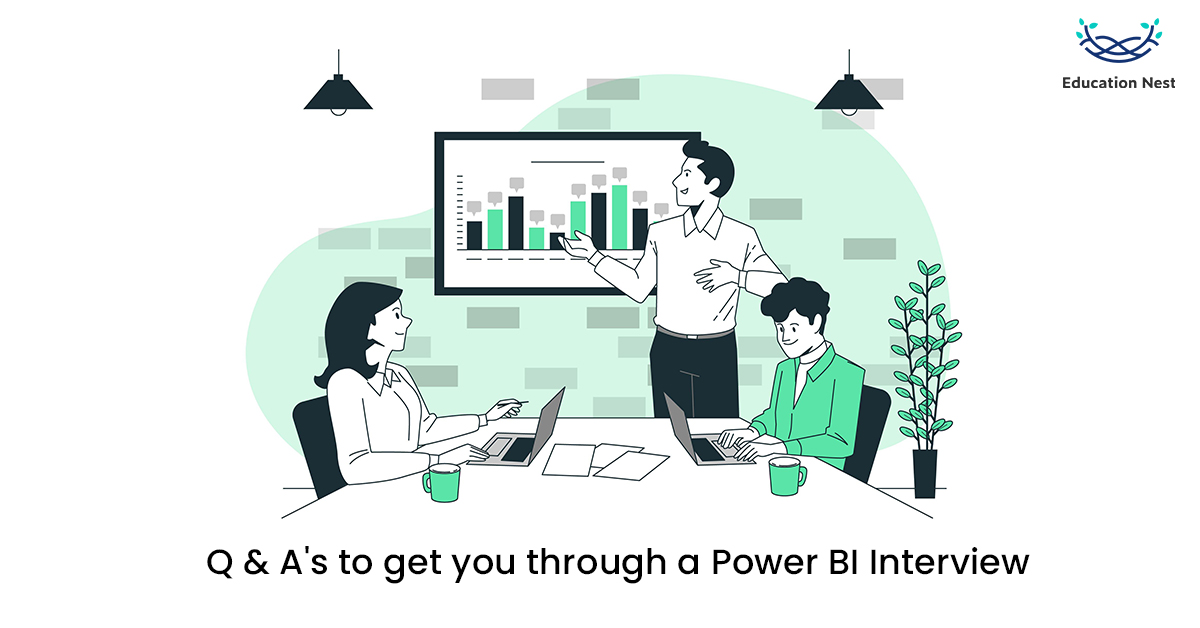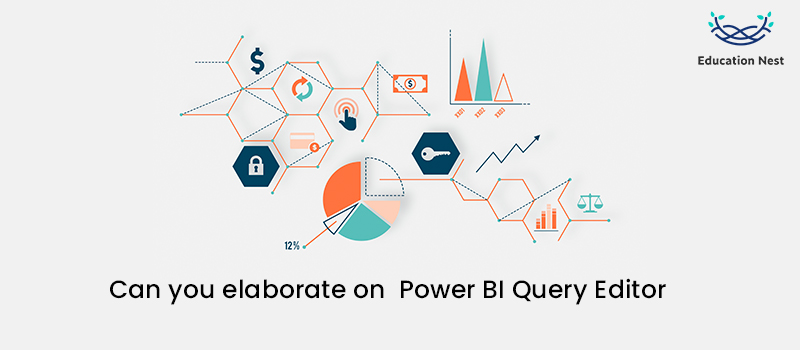
Preparing for a Power BI interview? Our guide covers the top 9 commonly asked questions in Power BI interviews, providing you with insights on what to expect and how to prepare. We also provide sample answers and tips to help you present yourself as a knowledgeable and confident candidate. Whether you’re a beginner or an experienced Power BI user, our guide will help you to feel more prepared and confident for your upcoming interview. Read on to master these top 9 Power BI interview questions.
What is BI?
A business intelligence tool, sometimes known as a BI tool, is a software application used to compile, analyze, and visualize vast amounts of data. This data processing is done to produce valuable business insights and interactive reports and make decision-making easier. These BI solutions provide elements like KPI scorecards, visual analytics, interactive dashboarding, and data visualization.
Power BI is a group of software services, applications, and connectors that combine to transform your diverse data into meaningful, engaging visuals and interactive insight.
Microsoft Power BI visualisation tool is a web-based package of corporate analytics tools that excel in data visualisation. Its features let the user identify real-time patterns and help improve their campaigns.
Power BI makes it simple to connect your data sources, view the data, identify the most crucial information, and share it with whomever you want.
The need for experts who know how to use this instrument has risen dramatically in recent years. This blog on Power BI Interview Questions seeks to get you ready for Power BI-related interview questions for jobs in big companies that pay well.
Starting from the most basic questions, we will move forward to questions that require expert knowledge.
- What makes Power BI appealing to you? Why would a job in Power BI be rewarding?
Users can create reports online with Power BI, a cloud-based data reporting and visualisation application. Users can distribute reports they have made to their coworkers at work. Because of this feature, Power BI is quite well-liked by corporate users. Consequently, Power BI is an exciting professional choice.
- What constitutes Power BI’s core elements?
Power BI is made up of five different elements.
- Power Pivot: Data is fetched, cleaned, and loaded onto Power Query.
- Power Query: Employs the information that has been loaded.
- Power Q&A: Enables users to communicate with reports using basic English
- Power View: Users can build interactive maps, graphs, charts, and other graphics
- Power Map: Facilitates the handling of precise geographical locations in data
- Can you shed some light on the difference between Power BI and Tableau?
- Multidimensional Expressions (MDX) are used by Tableau for measures and dimensions.
Power BI uses Data Analysis Expression (DAX) to calculate measures.
- Tableau can manage massive amounts of data.
Power BI can only manage a certain amount of data.
- Tableau is best suited for professionals.
Both novices and specialists can use Power BI.
- Tableau’s user interface might be challenging.
The Power BI User Interface is significantly easier to use.
- Cloud support is no problem for Tableau.
Due to its limited ability to manage significant amounts of data, Power BI finds it challenging to provide cloud support.
You Must Like: Power BI Vs Tableau: Which BI is better for you?
- Describe DAX. What advantages do variables have in DAX?
Data can be accessed and returned by a table expression using DAX or Data Analysis Expressions. The data in Power Pivot can be subjected to elementary computations and data analysis using this formula language. Calculated columns, calculated fields, and measures are also computed using it. Data cannot, however, be added to or changed using DAX.
DAX Syntax:
Total Sales = SUM(Sales[SalesAmount])
Where “Total Sales” is a “Measure,” “SUM” is a “DAX Function,” and “Sales[SalesAmount]” stand for the linked table’s name and its column, respectively.
Variables can be reused in DAX queries, preventing the need for further questions to the underlying database.
DAX expressions are understandable thanks to variables.
- Can you elaborate on Power BI Query Editor?

Users can load data from a broader range of data sources and perform changes using Power BI Query Editor, including adding additional columns and measurements.
Four tabs are present in the Power BI Query Editor:
- Home
Users can import data from the Query Editor into the New Query group.
Create and manage parameters using the parameter group.
Add a feature that allows you to update the dataset’s preview data for the current table or all tables.
Manage columns, scale back rows, and group items.
- Transform
Columns in the Any Column group can have their data types changed, their names changed, their values replaced, and errors fixed.
The structured column group provides options for handling nested data.
The Power BI Query Editor’s Run R Script function makes it possible to execute R Queries directly.
- Add Column
Use Add Column To build a new column using a DAX formula
Use conditional columns to add a column dependent on the values in another column.
Apply statistical, conventional, and scientific functions on numerical columns using the From Number group.
- View
View Settings for the Query Editor, showing or hiding
To see and modify the query code from here, visit the Advanced Editor window.
- Power Pivot utilises which in-memory analytics engine?
Power Pivot uses xVelocity as its main in-memory analytics engine. Due to its use of columnar databases for data storage, this engine can manage massive volumes of data. The data is loaded into RAM during in-memory analytics, which makes the processing pace incredibly quick.
- Power BI offers what gateways, and why would you use them?
Essentially, a gateway serves as a bridge between local data sources and Azure Cloud Services.
Personal Gateway: Only the Power BI Service can import and validate data. Additionally, only one individual can utilise this portal at a time.
Additionally, only one individual can utilise this portal at a time. The personal gateway’s more sophisticated counterpart is the on-premises gateway. Multiple users can use this to refresh data because it supports Direct Queries.
- What kind of functionality does the Schedule Refresh feature have?
Users can configure data refreshes to occur automatically based on daily or weekly requirements. If a user still needs Power BI Pro, they are able to plan one refresh per day at most. The pull-down menu options in the Schedule Refresh section are used to choose a frequency, time zone, and day of the week.
- How does Power BI handle data security?
A table that filters its rows during query processing requires the application of a DAX expression. When designing security roles for dynamic security, USERNAME functions will be used. The model will also include a table that links people to particular characteristics and responsibilities.
This tutorial is only intended to assist aspiring Power BI professionals in understanding the foundations of the software and succeeding in live interviews. The above frequently asked Power BI interview questions for experienced and new candidates can help one prepare for the job interview.

